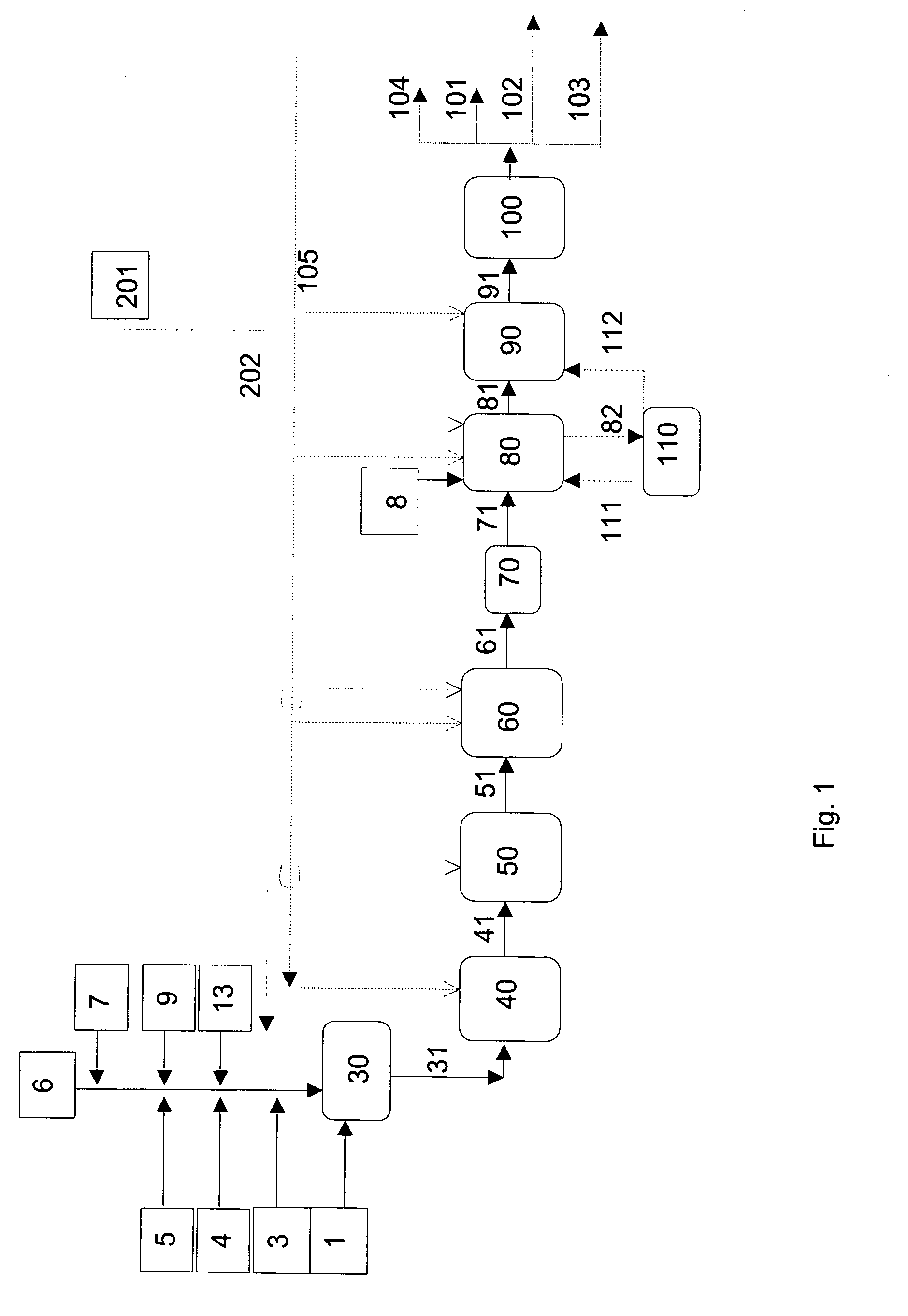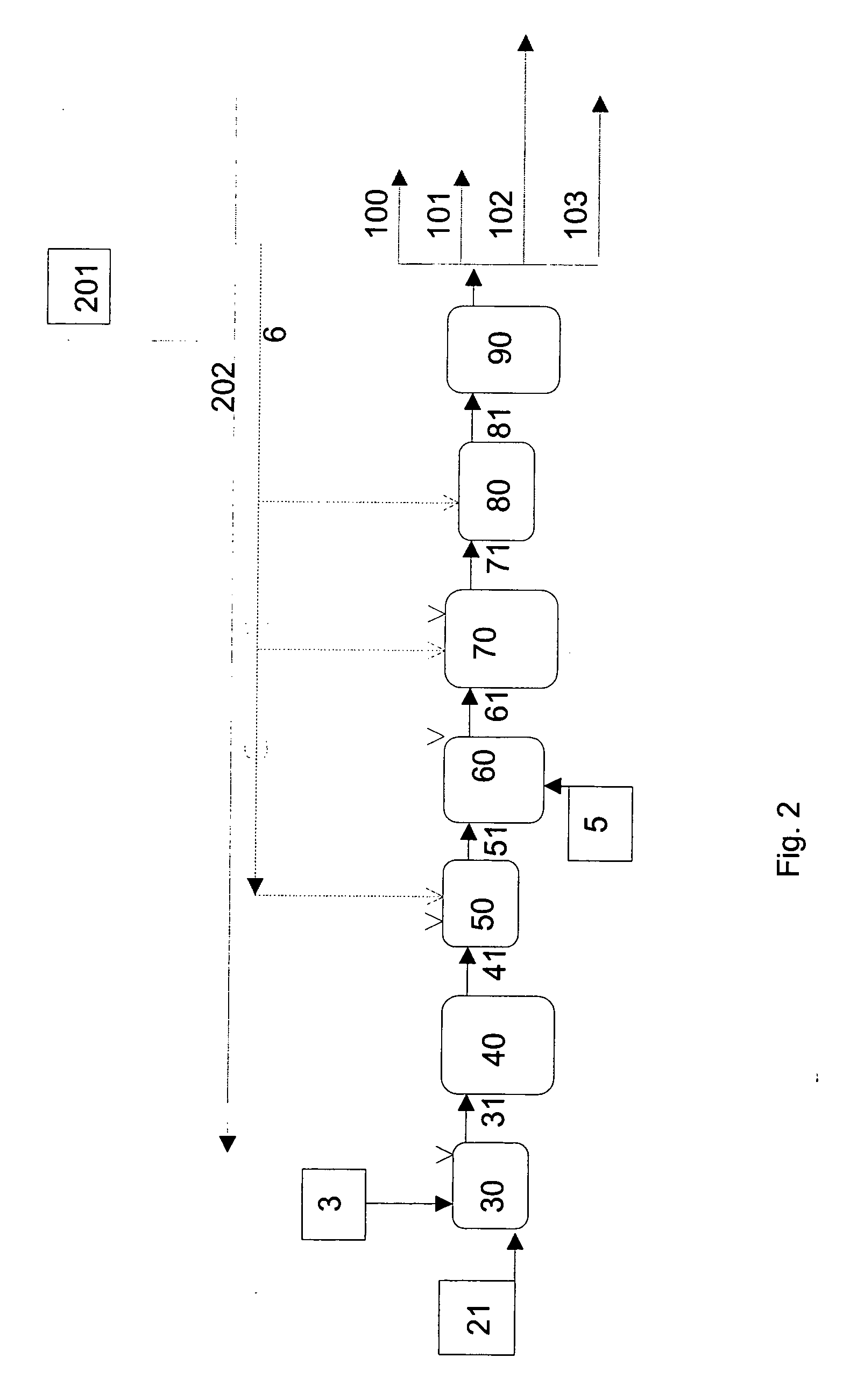Process for producing a hydrocarbon component
a technology of hydrocarbon components and hydrocarbons, applied in the direction of hydrocarbons, hydrocarbons from oxygen organic compounds, fatty acids chemical modifications, etc., can solve the problems of not being able to produce lubricants that meet the requirements, high volatility and a modest viscosity index, and the response of mineral oils to antioxidant additives is often low, so as to reduce carbon dioxide emissions contributing to the greenhouse effect, improve low temperature properties, and reduce the pour point
- Summary
- Abstract
- Description
- Claims
- Application Information
AI Technical Summary
Benefits of technology
Problems solved by technology
Method used
Image
Examples
example 1
[0158] Preparation of a Hydrocarbon Component from Stearic Acid Fraction (C17H35COOH)
[0159] A mixture of plant oils (linseed, soybean, and rapeseed oils) was pretreated by hydrolysis and distillation to obtain fatty acid fractions according to carbon numbers. The C18 acid fraction thus obtained was used as the feed, the fraction being diluted with a paraffinic diesel fuel of biological origin. C18 acid content of the feedstock thus obtained was 31%, by weight. Double bonds of the feedstock were selectively prehydrogenated, and the stearic acid was continuously ketonised at atmospheric pressure, in a tubular reactor using a MnO2 catalyst. Temperature of the reactor was 370° C., the WHSV of total feed being 3 l / h. 22% by weight of 18-pentatriacontanone, or stearone, in a diluent was obtained as the ketonisation product.
[0160] In the next step, the stearone / diluent mixture obtained above was hydrodeoxygenated in a high pressure Parr reactor using a dried and activated NiMo / Al2O3 cata...
example 2
[0162] Preparation of a Hydrocarbon Component from Fatty Acids Derived from Palm Oil
[0163] Palm oil was hydrolyzed. Fatty acids derived from palm oil were used as the feedstock following selective prehydrogenation of the double bonds of said fatty acids. After hydrogenation, the fatty acid composition was as follows: C14 1%, C16 44%, C18 54%, and C20 1%, all percentages being by weight. The fatty acids were ketonised as in Example 1. Following ketonization, the solvent was distilled off, yielding a product with the following composition: C15SCOC15 ketone, 10.4%, C15COC17 ketone, 42.1%, and C17COC17 ketone, 43.6%, by weight.
[0164] The ketone mixture obtained from the ketonisation stage was hydrodeoxygenated in a Parr reactor using a dried and activated NiMo / Al2O3 catalyst to give linear paraffins. Hydrodeoxygenation was carried out under a pressure of 3.3 MPa, at 330° C., mixing at 300 rpm. Linear paraffin with the composition: C33 chain 41.8%, C34 chain 2.1%, and C35 chain 43.8% b...
example 3
[0167] Preparation of a Hydrocarbon Component from Methyl Esters of Fatty Acids Derived from Animal Fats
[0168] Purified animal fat was transesterified under basic conditions with methanol at 70° C., under a pressure of 0.1 MPa, in the presence of a sodium methoxide catalyst in two steps, thus producing methyl esters of fatty acids. The reaction mixture was purified by washing with acid and water, and the mixture of fatty acid methyl esters was dried. The fatty acid composition of the mixture of methyl esters derived from animal fat was as follows: C14:0 2%; C16:0 23%, C16:1 3%, C18:0 13%, C18:1 40%, C18:2 11%, C18:3 1% by weight.
[0169] The mixture of fatty acid methyl esters obtained above was used as the feedstock of the process, diluted with paraffinic diesel of biological origin. The fatty acid methyl ester content of the feedstock was 30% by weight, the feedstock being continuously ketonised in a tubular reaction as described in Example 1. Both saturated and unsaturated ketone...
PUM
| Property | Measurement | Unit |
|---|---|---|
| viscosity index | aaaaa | aaaaa |
| viscosity index | aaaaa | aaaaa |
| temperature | aaaaa | aaaaa |
Abstract
Description
Claims
Application Information
 Login to View More
Login to View More - R&D
- Intellectual Property
- Life Sciences
- Materials
- Tech Scout
- Unparalleled Data Quality
- Higher Quality Content
- 60% Fewer Hallucinations
Browse by: Latest US Patents, China's latest patents, Technical Efficacy Thesaurus, Application Domain, Technology Topic, Popular Technical Reports.
© 2025 PatSnap. All rights reserved.Legal|Privacy policy|Modern Slavery Act Transparency Statement|Sitemap|About US| Contact US: help@patsnap.com



